Orange FM Gameboy Cart
Links
What is Orange FM?
Orange FM is a modern cartridge for the Game Boy family of handhelds. You can think of it as a car stereo system in a cartridge, featuring digital tuning, presets, basic radio text support, and other fun features!
Fully populated and soldered boards are available for purchase - you only need to trim a cartridge shell to fit. A DIY version (you buy/solder 90% of the parts) is also available!
Features
- World Band 64-108Mhz FM Radio
- Uses the Game Boy's Speaker (See compatibility chart)
- On-Cart Stereo Headphone Amp
- Store and Recall 12 Presets
- RDS Radio Text Support
- Internal and External Antenna Support
- Digital Volume Adjustment
- Many Configurable Options, (See Manual)
Compatibility
| Mono Audio Output Through Console Speaker | Stereo Audio Through On-Cart Headphone Amp | |
|---|---|---|
| Original Game Boy (DMG) | Yes* | Yes |
| Game Boy Pocket (MGB) | Yes* | Yes |
| Game Boy Light (MGL) | Yes* | Yes |
| Game Boy Color (CGB) | Yes** | Yes |
| Game Boy Advance (AGB) | No | Yes |
| Game Boy Advance SP (AGS) | No | Yes |
| Super Game Boy | Yes (Through TV) | Yes |
| Game Boy Player | No | Yes |
| Analogue Pocket | Yes*** | Yes |
| FunnyPlaying GBC | No | Yes |
| ModRetro Chromatic | No | Yes |
* Quiet volume
** Loud volume
*** As of Firmware 2.3
Manuals
- ROM Manual (Latest - Version 1.4)
- ROM Manual (Version 1.3)
- ROM Manual (Version 1.2)
- ROM Manual (Version 1.1)
- ROM Manual (Version 1.0)
- ROM Manual (Version 0.4)
- ROM Manual (Version 0.3)
External Antennas
An external antenna is not required, but will greatly boost reception. Here are some options!
- 3ft aux cable : Best reception typically. This is a thin one I like, but you can use any aux cable. 3ft to one meter is an ideal size. You can use a shorter one if you want, it'll just lower the reception a bit.
- Long telescopic antenna : Good to great reception, comically large
- Short straight telescopic antenna : Decent reception, usable size
- Right-angle telescopic antenna : Decent reception, usable size, you'll poke your eye out
- Most pairs of wired headphones should make a very good antenna.
FAQ
How does the speaker output work?
All Game Boy models until the GBA have an audio input capability on the cartridge connector. This makes it fairly easy to send mono audio into the Game Boy, where it is mixed with the internal sound hardware. The input volume depends on the model, with the Game Boy Color performing the best.
This feature was never officially (to my knowledge) used by Nintendo, although some other projects like the Nanoloop Mono make use of it.
How hard would assembling my own cart be?
If you purchase an assembled PCB, all you need to do is cut a cartridge shell to fit. No soldering is required!
Building your own DIY Orange FM cart from scratch requires experience with fine-pitch SMD soldering. Additionally, there is one QFN package chip you'll need to solder with hot air, hot plate, etc. So this is not a soldering project for beginners!
What is the situation with the antenna / reception?
Orange FM supports both a built-in antenna (which requires nothing to be attached to the cart), as well as an external antenna connected to the cart's 3.5mm antenna/headphone jack.
The built-in antenna offers fairly weak, but often usable reception. The station strength may be a bit positional, and you're likely to only receive the strongest local stations. This is great if you just want to casually blast some tunes from the Game Boy speaker, as you don't need to attach anything extra to the cart.
To improve the reception, you can attach an external antenna to the cart through the 3.5mm antenna/headphone jack. This can be a pair of headphones, a telescopic antenna, a 3.5mm aux cord, or a purpose-made antenna cord. It's easy to make your own antennas, so you can experiment if you like! The external antenna interface will offer stronger, more reliable reception, depending on the length of your antenna. The best performing antenna is typically a 1 meter long cable, about the same length as the average headphone cord.
Will Orange FM work in my country?
Probably. Orange FM supports 87.5 - 108 MHz for most of the world, and 76 - 95 MHz for Japan. There is also a full range mode that will give you 64 - 108 Mhz. You can choose between 200 kHz (e.g. 88.5, 88.7, 88.9, etc) and 100 kHz (e.g. 88.5, 88.6, 88.7, etc) spacing options. You can also select the de-emphasis (50us or 75us) which varies depending on where in the world you are.
Italy may use 50 kHz spacing (e.g. 88.75) for some stations - unfortunately Orange FM can't tune to these stations at present.
Can you support AM / DAB / HD Radio / Weather?
Not happening for Orange FM, as I've already committed to the current radio chip I'm using.
Could you make a GBA-sized version?
In a standard GBA-cart shell - no. Similar to Boktai or other "larger" GBA games - maybe. But don't expect one!
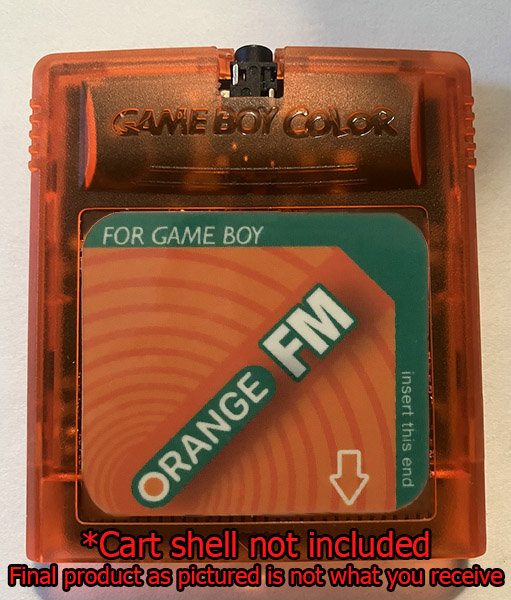
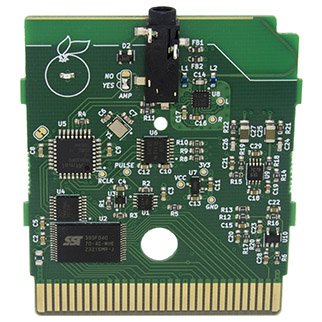
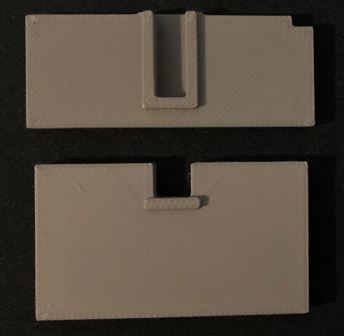
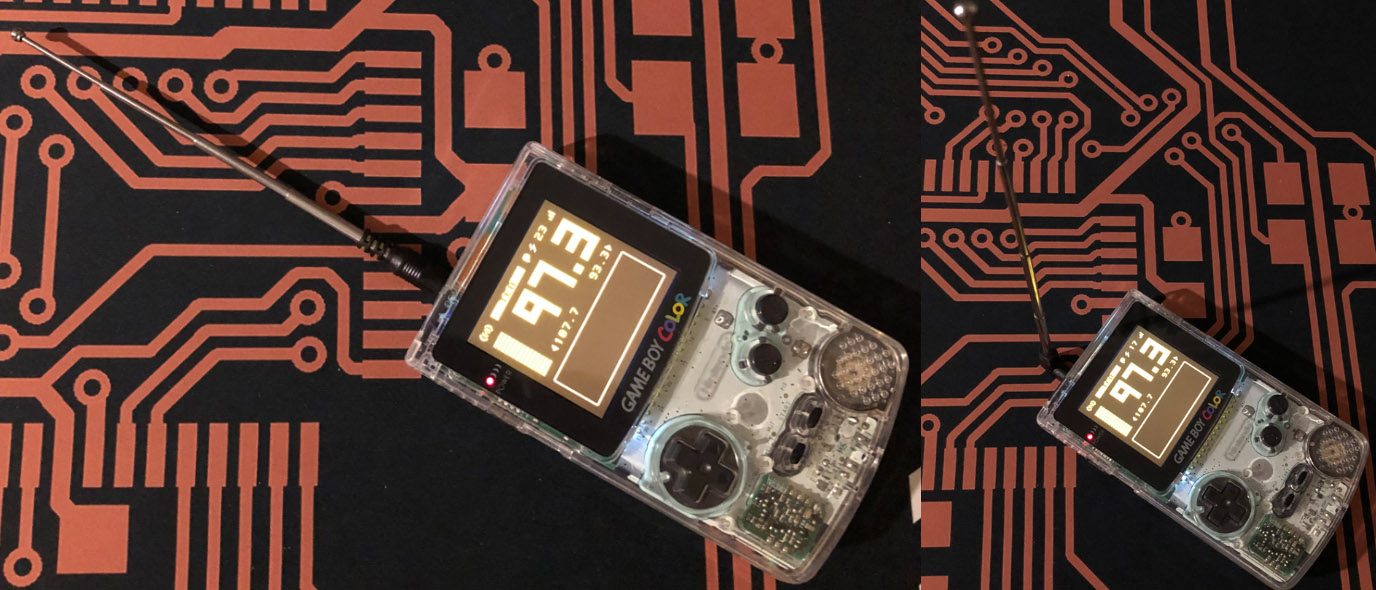
Price: $61.00 USD
Orange FM is a cartridge for Game Boy that allows you to listen to FM radio stations through your Game Boy’s speakers (on certain models, see compatibility chart below). It features an internal antenna for strong signals, as well as support for external antennas connected to the cart’s audio jack. In addition to mono audio output through the console, the cart delivers stereo audio through the cart’s audio jack to connected headphones or speakers.
A portion of your payment goes to orangeglo, the product creator. Designed in the USA, assembled in Australia.
If you order the assembled PCB, you’ll receive:
- A fully assembled Orange FM circuit board, no soldering required
- An Orange FM cart label (non-holographic)
To complete this project, you will need:
- A cartridge shell. We recommend a GBC style shell. You can use a DMG style shell as well, but trimming the shell to fit the headphone jack is more difficult. Trimming/filing of the shell is required for the PCB to fit, due to the audio/antenna jack. A 3d printed cutting guide is available as an optional purchase, or you can print your own. There is a tutorial on how to use the cutting guide.
Questions or need support? Join the OrangeFM Discord
A DIY version of this product is also available
Description
Features
- World Band 64-108Mhz FM Radio
- Uses the Game Boy’s Speaker (See compatibility chart)
- Stereo Headphone Amp
- Store and Recall 12 Presets
- RDS Radio Text Support
- Internal and External Antenna Support
- Digital Volume Adjustment
- Many Configurable Options, See Manual
Compatibility
| Mono Audio Output Through Console Speaker | Stereo Audio Through On-Cart Headphone Amp | |
|---|---|---|
| Original Game Boy (DMG) | Yes* | Yes |
| Game Boy Pocket (MGB) | Yes* | Yes |
| Game Boy Light (MGL) | Yes* | Yes |
| Game Boy Color (CGB) | Yes** | Yes |
| Game Boy Advance (AGB) | No | Yes |
| Game Boy Advance SP (AGS) | No | Yes |
| Super Game Boy | Yes (Through TV) | Yes |
| Game Boy Player | No | Yes |
| Analogue Pocket | Yes, v2.3+*** | Yes |
| FunnyPlaying GBC | No | Yes |
| ModRetro Chromatic | No | Yes |
* Quiet volume
** Loud volume
*** Please make sure to change your gain setting to “Analogue” or else the audio will be super loud and blown out!
Reception
Internal antenna: The internal antenna will be used if nothing is plugged into the cart’s audio jack. The internal antenna is fairly weak, but can pick up strong signals from local stations.
External antenna: Using an external antenna is recommended for the best reception. The ideal antenna is a meter long cord – a pair of headphones works great, as does a standard 3.5mm aux cable. You can also build your own antennas – see the diy guide. If you’re looking for a telescopic antenna, these small Aliexpress antennas work fairly well – option 1 or option 2.
Please keep in mind that a game boy cartridge is a less than ideal format for a FM radio – reception strength is not comparable to a car stereo, or dedicated FM radios.
Orange FM - ROM Manual Version 1.4
Features
- World Band 64-108Mhz FM Radio
- Uses the Game Boy's Speaker (See compatibility chart)
- On-Cart Stereo Headphone Amp
- Store and Recall 12 Presets
- RDS Radio Text Support
- Internal and External Antenna Support
- Digital Volume Adjustment
- Many Configurable Options
Compatibility
| Mono Audio Output Through Console Speaker | Stereo Audio Through On-Cart Headphone Amp | |
|---|---|---|
| Original Game Boy (DMG) | Yes* | Yes |
| Game Boy Pocket (MGB) | Yes* | Yes |
| Game Boy Light (MGL) | Yes* | Yes |
| Game Boy Color (CGB) | Yes** | Yes |
| Game Boy Advance (AGB) | No | Yes |
| Game Boy Advance SP (AGS) | No | Yes |
| Super Game Boy | Yes (Through TV) | Yes |
| Game Boy Player | No | Yes |
| Analogue Pocket | Yes*** | Yes |
| FunnyPlaying GBC | No | Yes |
| ModRetro Chromatic | No | Yes |
* Quiet volume
** Loud volume
*** As of Firmware 2.3
Analogue Pocket
As of Pocket Firmware 2.3, the Analogue Pocket supports speaker output for Orange FM! To use Orange FM on the Pocket, you'll want to set the Gain in the Radio Settings to "Analogue". The Pocket requires less output volume from the cart, so without this setting engaged, the output will be very distorted. With "Analogue" selected, the sound output will be excellent. The Analogue Pocket makes a really great portable radio, with loud speaker output!
Note: If you use the "Run as GBA" option, you will not have any sound output through the system, as the GBA does not support speaker output, and your Orange FM cart will think it's in a GBA.
Sound Output
Orange FM use the audio input pin feature of the early Game Boy models, which allows for mono sound to be passed into the Game Boy through the cartridge header. This means you can use the Game Boy speaker to listen to the radio, no headphones required! This is the main difference between the cheap FM radio perhipherals available in the Game Boy's heyday and Orange FM - while those accessories simply used the Game Boy for power, Orange FM actually uses the Game Boy as the audio amplifier, allowing the speaker to be used!
The cart outputs high quality, but mono, sound to the Game Boy. Each Game Boy will have it's own quirks with the audio amp, depending both on the model (DMG, MGB, CGB), but also on the individual unit. A general rule - the better and less noisy the headphone output is while playing a game, the better and less noisy Orange FM will sound. It's fun to experiment with different Game Boy's and find the one with the sound you prefer.
Orange FM also includes a headphone amplifier as part of the cart's 3.5mm jack. With a pair of headphones plugged into the 3.5mm jack, not only will you get improved reception, but you'll also get stereo sound (with adequate signal strength)! The feature enables Orange FM to be used on Game Boy Advance models (except the Micro of course), as well as the FunnyPlaying GBC and other consoles.
Tuner
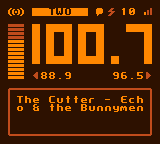
 Internal antenna / external antenna
Internal antenna / external antenna Headphone amp engaged
Headphone amp engaged Current preset, or other status information
Current preset, or other status information Update mode: Off, Sig, Sig + RDS
Update mode: Off, Sig, Sig + RDS Lights when RDS is syncing, or data is available to manually sync
Lights when RDS is syncing, or data is available to manually sync Signal strength: Signal-to-noise ratio (db)
Signal strength: Signal-to-noise ratio (db)
Controls
- Up/Down: Adjust volume
- Left/Right: Switch presets
- A: Seek
- B (Short Tap): Toggle Mute
- B (Hold): Manually sync data
- B (Hold) + Left/Right: Manually tune radio frequency
- B (Hold) + A: Enter lock mode
- B (Hold) + Select: Toggle headphone amp
- Select: Toggle preset (Hold to remove)
- Start: Switch to Settings
Antennas
Internal Antenna
Orange FM has a built-in internal antenna that is used when nothing is inserted into the 3.5mm jack. While it is possible to get decent reception of strong signals, you may find that reception is quite positional - you may need to experiment with the Game Boy's orientation to get the best quality signal.
External Antennas
For best reception, you'll want to have an external antenna connected. You have many options for external antennas, as the antenna circuit is quite flexible. The general rule - the longer the better (at least up to 1.5 meters). The sleeve (ground) of the jack is connected to the antenna circuit, so you can make your own antennas buy wiring speaker cable or similar to a 3.5mm plug. Or you could purchase a 3.5mm aux cable and cut it to length!
Update Modes
- Sig + RDS: Signal strength information will be updated in the background. The station text (RDS) will be synced automatically if data is available. Audible interference noise may be present depending on the signal strength. This mode works best with an external antenna attached.
- Sig: Signal strength information will be updated in the background. No station text (RDS) will be synced. Audible interference noise may be present depending on the signal strength. This mode works best with an external antenna attached.
- Off: No data will be updated in the background. This mode will produce zero background inteference.
Lock
Orange FM has a customizable lock feature, disabling keypad input except for your chosen wake keys. You can even have the display turn off, to save additional power on an original Game Boy display. Additionally, you can assign specific update modes for when the lock is on, allowing you more flexibility. For example, you could have "Sig + RDS" as your normal update mode, then switch to "Off" when you lock the system.
Settings
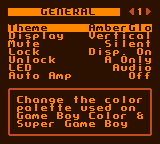
Controls
- Left/Right: Switch page
- Up/Down: Change selection
- A: Change setting (forward)
- B: Change setting (backward)
- Start: Switch to Tuner
Page: General
- Theme: Select a color theme to use. Color systems have eight different themes to choose from, as well as a "Custom" option. On B/W systems, a light and dark theme are available.
- Custom: Press select to open the palette editor. Use the DPad to select the current color component, A and B to adjust the selected component, and Select to cycle the three different colors into different positions. By selecting the bottom row, you can either discard with B, or save your palette with A.
- Display: Swap between vertical and horizontal screen orientations
- Mute: Pick between a truly silient mute or a quiet mute, where the volume is reduced significantly.
- Lock: Choose whether the display is turned off when the system is locked. This is only really useful on non-modified systems, as aftermarket screen kits are unlikely to actually turn off the screen.
- Unlock: Select which key(s) exit lock mode.
- LED: Choose what you want the cart's LED to do.
- Signal Str: LED brightness changes depending on the signal strength of the current station
- Audio: LED changes intensity in relation to the audio signal
- Data Sync: LED illuminates when data is transfered from the radio to the Game Boy
- Off: LED always stays off
- Auto Amp: When this option is on, the headphone amp will turn on automatically when you insert something into the cart's 3.5mm jack.
Page: Radio
- Gain: Select between different gain levels, which will affect how loud the output is. Depending on the loudness of the broadcasted audio signal, higher gain settings may produce some distortion. This can be a useful setting to get a little more volume from the Game Boy's speaker. There is also an "Analogue" mode designed for the Analogue Pocket, which requires much less output.
- Hi-Cut: Roll off some high frequency content with a high-pass filter. This can be used to warm up the audio, or reduce the harshness of the speaker output.
- Range: Select the frequency range of the tuner. Most countries use 87.5 - 108. Japan uses 76 - 95. You can also select the full tuning range of 64 - 108 if desired.
- Spacing: Choose between 200 khz (odd only) or 100 khz (odd and even) station spacing for the 87.5 - 108 frequency range. USA uses 200 khz spacing (ex allowing 99.1, 99.3, but not 99.2), while many other countries will use 100 khz spacing to allow for both odd and even frequencies.
- De-Emph: Change the de-emphasis setting. Different countries use either 75us or 50us. This will affect the high frequency content of the signal, as well as the reception strength (by a minor amount). North America and Japan use 75us, while Europe and much of the rest of the world use 50us.
- Seek: Adjust the sensitivity of the seek function. High sensitivity will result in more stations being picked up, and Low vice-versa etc.
- Presets: Choose preset navigation style. In Order will go by the preset number, while By Freq will go to the next/previous preset by frequency.
Page: Data Sync
- Manual: Pick the update mode used when you press and hold B on the tuner screen. Typically you'll want this set to Sig+RDS.
- Int. Ant: Pick the update mode for the internal antenna, when not locked. See Update Modes section futher up.
- Int. Lock: Pick the update mode for the internal antenna, when the lock is engaged. See Update Modes section futher up.
- Ext. Ant: Pick the update mode for the external antenna, when not locked. See Update Modes section futher up.
- Ext. Lock: Pick the update mode for the external antenna, when the lock is engaged. See Update Modes section futher up.
Page: Controls
A quick controls reference.
Page: About
View the current firmware and ROM versions, as well as see what model of Game Boy is being detected. Also, shoutouts to the folks who helped me bring this project to life!
Page: Reset Mem
Press A + B to perform a full reset of the cart. This will clear your presets, and set all settings back to their defaults.
Attributions
- Cushion font by Damien Guard (Free with credit)
https://damieng.com/typography/zx-origins/cushion/ - RDSDecoder Arduino library by Radu - Eosif Mihailescu (LGPL v3)
https://github.com/csdexter/RDSDecoder - Smooth Arduino library by ripred (MIT)
https://github.com/ripred/Smooth - kicad-gamepaks by djeddit (CC-BY-4.0)
https://github.com/djedditt/kicad-gamepaks